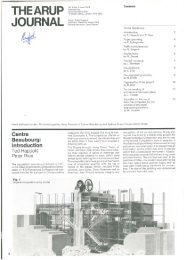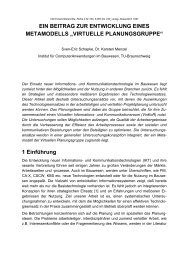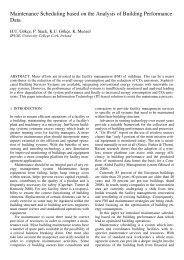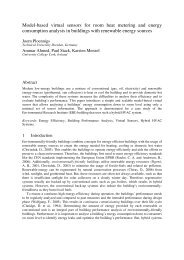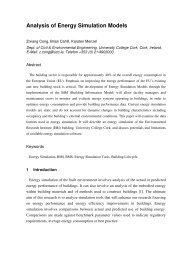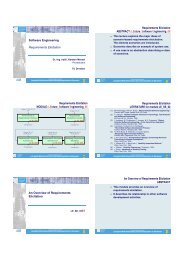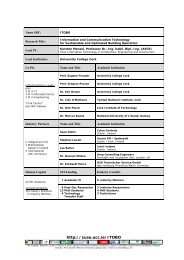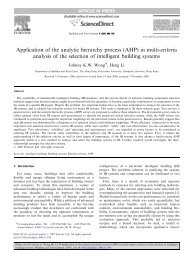A Middleware Architecture Supporting Native Mobile Agents for ...
A Middleware Architecture Supporting Native Mobile Agents for ...
A Middleware Architecture Supporting Native Mobile Agents for ...
Create successful ePaper yourself
Turn your PDF publications into a flip-book with our unique Google optimized e-Paper software.
A <strong>Middleware</strong> <strong>Architecture</strong> <strong>Supporting</strong> <strong>Native</strong><strong>Mobile</strong> <strong>Agents</strong> <strong>for</strong> Wireless Sensor NetworksCiarán Lynch and Dirk PeschCentre <strong>for</strong> Adaptive Wireless Systems,Cork Institute of Technology,Cork, Ireland,ciaran.lynch@cit.ie, dirk.pesch@cit.ieAbstract. <strong>Mobile</strong> Software <strong>Agents</strong> are widely used in telecommunicationnetworks and the Internet, however their application to embeddedsystems such as Wireless Sensor Networks is immature. We present anovel middleware supporting and enabling <strong>Mobile</strong> Agent applicationsto run natively, without any translation layer, on Wireless Sensor Networks.We establish that <strong>Mobile</strong> Agent systems are beneficial <strong>for</strong> a widerange of applications – particularly when dealing with complex, dynamicand spatially distributed tasks, and demonstrate their power and certainper<strong>for</strong>mance metrics <strong>for</strong> an example applications. We use an accurateemulation plat<strong>for</strong>m to evaluate the system per<strong>for</strong>mance in a distributedcontrol application implemented using mobile software agents.1 IntroductionThe challenges of reprogramming Wireless Sensor Networks (WSN) after theyhave been deployed into the environment are well established. [1,2] Reprogrammingan entire sensor node program image is a time- and power-consumingprocess. Resetting the node also destroys any program state that has been establishedat the node.<strong>Mobile</strong> agent systems have been proposed <strong>for</strong> WSN, however they either donot execute directly on sensor nodes or use an interpretation layer on the nodes.The system presented here uses native mobile agents, written in standard C,that execute directly on the embedded wireless sensor nodes.Currently, there are no systems supporting true native mobile software agentson wireless sensor networks (see Related Work, Section 5). This paper presents apossible design of such a system. The proposed system builds on top of SOS [3],an existing modular operating system <strong>for</strong> WSN. Module support is tightly integratedinto SOS and we found it a good base on which to develop such a system.The primary contribution of this paper is the development and evaluation ofsuch a native mobile agent middleware system.In order <strong>for</strong> such a system to be useful, it must minimise the cost of operation– primarily the time and energy used to transmit the agent code. The middlewaresystem provides simple routing, reliable migration and remote module fetching,
2 Ciarán Lynch and Dirk Peschneighbour discovery and inter-agent communication. A weak mobility model issupported.The architecture of the system is discussed in Section 2, and a simple applicationto evaluate it in Section 3. Section 4 discusses the results presentedin the previous section. Related work is presented in Section 5, while Section 6concludes the paper.2 System <strong>Architecture</strong>The <strong>Mobile</strong> Agent System <strong>Architecture</strong> is shown in Figure 1. It is split into anumber of sub-sections. <strong>Agents</strong> execute as SOS modules, interacting with themiddleware when they require the services it provides, running on standardMicaZ sensor nodes.Agent Agent AgentAgent LevelMobility Security OperationManager Manager Manager<strong>Middleware</strong> LevelDynamicLinkerMemoryManagementHardware Interface LayerCommsOS LevelProgramMemoryRAMRadioHardware LevelFig. 1. System Block DiagramThe middleware must provide three types of services – Mobility, Security andOperations. The system is split into these three, essentially independent sections.The mobile agents as well as the middleware components are treated as normalcode modules in SOS, with access to all of the operating system functionality.2.1 Mobility ManagerAn agent requires the ability to move. In the simplest case, an agent can moveto another node within radio range. More complex movement operations enablemore dynamic and powerful agents.2.1.1 Agent Transfer The manager controls the transmission of agents toneighbours. This can be either a move or a copy. The agent is suspended inorder to capture a consistent snapshot of the agent state. An agent to be movedremains suspended until the transmission completes – if successful, the agent isthen terminated, if not it resumes with an error signal.
<strong>Middleware</strong> <strong>Supporting</strong> <strong>Native</strong> <strong>Mobile</strong> <strong>Agents</strong> <strong>for</strong> WSN 3A request is sent to the transfer node, and if it accepted, the transfer starts.The executable code is transmitted if necessary, followed by the agent state,including any dynamic memory allocated by that agent.Once the transfer has started, the sending node sends packets regularly. Eachpacket carries 64 bytes of in<strong>for</strong>mation. Selective-Repeat ARQ is used to ensurethat all packets are received successfully. Since the size of an agent is generallylimited to 10–20 packets, a sliding window would not be efficient. SR-ARQ givesbetter per<strong>for</strong>mance than simple ARQ in a lossy link, without overly complexresource requirements at the receiver.2.1.2 Conditional Move An agent may specify a move condition, allowingthe agent to move to a point of interest in a network and not a neighbour.Intermediate nodes will still receive a copy of the agent, however they will notexcecute it unless it has reached the end of the carrier path (the code is storedat the node <strong>for</strong> potential execution in the future). The condition has two parts,a move condition and a termination condition. The move condition is followed,until the termination condition is satisfied, or no further movement is possible.Four carrier move conditions are currently defined – these are sufficient <strong>for</strong>a simple application, more may be added if required. They are Move towardsnode N, Move along a gradient of a blackboard value (see Section 2.3.1), Movetowards a gateway node and Move to a random neighbour.Five termination conditions are defined – Execute at node N, Execute atthe top or bottom of gradient, Execute at non-zero blackboard value, Execute atgateway node and Move once and then execute.2.2 Security ManagerA node should not blindly trust every agent received. Malicious users can injectimproper agents, and errors or interference can result in an agent transmissionbecoming corrupted. A native agent does not have the protection of a bounded,virtual execution environment, and a corrupted agent will most likely crash thenode. An MD5 signature [4] is used to sign each agent with a secret key, knownonly to the nodes in the system and to authorised users of the system.2.2.1 Secret Key Central to the signature scheme is a secret key known toeach sensor node and to authorised users. This key is assumed to have beenplaced into each sensor node at the time of deployment or through a separatekey distribution protocol.2.2.2 Agent Integrity The transmission fails if the hash does not match thatgenerated locally. The sending or requesting agent is notified that the transmissionhas failed due to a security failure, and it is then free to take whateversubsequent action it deems appropriate.The hash also operates as an integrity check – a corrupted agent that isnot detected by the per-packet CRC check, or any misconfiguration in the middlewarethat causes the received image to be incomplete or incorrect will berejected.
4 Ciarán Lynch and Dirk Pesch2.3 Operation Manager2.3.1 Blackboard The blackboard is a remotely accessible address space (similiarto Agilla Tuples [5]). A 16-bit key is used to index the space. The blackboardprovides a simple, standard mechanism <strong>for</strong> discontinuous communicationbetween agents in a local one-hop network neighbourhood. It allows agents todeposit in<strong>for</strong>mation to be used in the future by other agents.2.3.2 Neighbour Management The manager maintains a list of neighbours.<strong>Agents</strong> can retrieve the list of current neighbours, query <strong>for</strong> new neighbours andselect a random neighbour. Nodes are automatically removed from the list aftera certain time.2.3.3 Remote Agent Request An agent requests the manager to find andexecute another agent. If the agent code is available at the node, it is started. Ifnot, a request <strong>for</strong> that agent is broadcast. Neighbouring nodes will <strong>for</strong>ward thisrequest and respond if the service is available. The agent is transferred by themobility manager.3 EvaluationThe middleware system was implemented and tested on MicaZ wireless sensornodes. The application evaluation presented here is based on the AvroraZemulation plat<strong>for</strong>m, as this provides detailed probes and instrumentation <strong>for</strong>measurement and testing, and allows repeatable and controllable experimentsto be per<strong>for</strong>med.3.1 AvroraZAvroraZ [6] is an extension of Avrora, a wireless sensor network emulator. It usesa detailed model of the AtMega128L microcontroller to execute the same binaryimage as the physical microcontroller. It reproduces precisely the constraintsof an embedded wireless sensor plat<strong>for</strong>m, allowing very accurate emulation ofcomplex applications, complete with the timing and memory constraints of thephysical system.AvroraZ adds support <strong>for</strong> the CC2420 radio used in the MicaZ wireless sensornode plat<strong>for</strong>m. The radio model used is based on actual measurements ofthe per<strong>for</strong>mance of MicaZ nodes, and has been shown to correspond well withmeasurements from real sensor nodes [6].3.2 Physical ScenarioThe simulated scenario is a distributed control application. 25 nodes are placedin 3 rooms, with 3 nodes connected to heaters. The system is self-configuring,
<strong>Middleware</strong> <strong>Supporting</strong> <strong>Native</strong> <strong>Mobile</strong> <strong>Agents</strong> <strong>for</strong> WSN 5self-managing and robust – once one agent is pushed into the network, it operatesautonomously, even in the presence of node resets and failures.The nodes are arranged as shown in Figure 2. Each node knows which roomit is in (from 1 to 3) and whether or not it is attached to a heater. Every nodehas a temperature sensor. Each heater can be in one of 4 states – Off, Low,Medium or High. Each simulation is run <strong>for</strong> 6 minutes in total.Heater0 1 2 3 45 6 7 8 910 11 12 13 1415 16 17 18 1920 21 22 23 24Fig. 2. Physical Scenario3.3 <strong>Agents</strong>The agent sizes are shown in Table 4.3.3.1 Management Agent The management agent moves around the network,discovering nodes as it moves. On discovering a node connected to a heater,it summons a control agent if none exists. The control agent is given the list ofnodes in the current room. This is updated each time the management agentrevisits the control agent. The management agent keeps a list of nodes that werepreviously reachable but that are currently unreachable.3.3.2 Control Agent (static) Every 10 seconds, it summons a data gatheringagent to take readings from around the room. Once started, the control agentexpects to get regular visits from the management agent. If one minute passeswithout any visit, the control agent will summon a new management agent,which will begin crawling the network from the current node.3.3.3 Data Gather Agent This agent moves around each node in the roomand takes a sensor reading. It returns these readings to the control agent.3.3.4 Reporting Agent The reporting agent remains at an externally connectednode. It receives the list of failed nodes from the management agent.Only a test agent is implemented.
6 Ciarán Lynch and Dirk Pesch3.4 Agent <strong>Middleware</strong>The agent middleware, including the complete SOS operating system but withoutany agents occupies 77.8kB of the 128kB FLASH memory on the MicaZnode. This leaves 50.2kB <strong>for</strong> agent code. This is com<strong>for</strong>tably more than hasbeen required in any application tested.3.3kB of the 4kB of available RAM is used, including 2kB reserved <strong>for</strong> thedynamic memory heap – this is available to be used by agents and applications.The remaining 705 bytes is used <strong>for</strong> the program stack.3.5 ResultsResults of the evaluation are shown in Table 1. Startup Time is the time <strong>for</strong> themanagement agent to discover and visit every node in the system. ManagementPeriod is the average time between visits of the management agent to eachnode. Gathered Values is the average number of nodes visited by the data gatheragent. Ideally this would be 8.3, however only 6.6 values are in fact being usedper reading. Some moves fail due to congestion or due to incomplete networkdiscovery at that point.The per<strong>for</strong>mance of the middleware itself is given in Table 3. Move Time isthe average total time <strong>for</strong> an agent move between nodes (per hop), includingrouting and transfer. Routing Time is the average time to find a particularnode. The average time spent executing at each node <strong>for</strong> the datagather andmanagement agents are shown as Execution Time DG and Execution Time Man.The node setup was altered <strong>for</strong> some simulation runs, to test the resilienceand self-management capability of the system (Table 2). Nodes 6, 17 and 19 arenot started until 3, 4 and 5 minutes respectively. The time taken to incorporatethem into the system is Late Start Reset Test switches off nodes 9 and 10 after140 and 250 seconds respectively, and reset and switches them on 50 secondslater. The time taken to reincorporate them into the system is almost the sameas the late start test, as the mechanism is very similiar.OperationValueStartup Time 58.12sManagement Period 18.72sGathered Values 6.59Table 1. Normal OperationOperationValueMove Time (per hop) 364.1msRouting Time 44.3msExecution Time (DG) 8.1msExecution Time (Man) 2.2msTable 3. <strong>Middleware</strong> Per<strong>for</strong>manceOperation ValueLate Start 15.3sReset Test 15.9sTable 2. Failure RecoveryAgentSizeManagement 1220Control 644Data Gather 880Table 4. Agent Sizes
4 Significance and Discussion<strong>Middleware</strong> <strong>Supporting</strong> <strong>Native</strong> <strong>Mobile</strong> <strong>Agents</strong> <strong>for</strong> WSN 74.1 Robustness and Self-ManagementThe system uses interlocking agents to guarantee reliability. The loss of anyagent or node in the network will not lead to complete system failure. If a noderesets, the next time the management agent visits, the control agent will bereestablished. A new data gathering agent is genereated <strong>for</strong> each operation, losswill simply limit the current control operation. The most damaging failure isthe failure of the management agent. Assuming that at least one of the controlagents survives, it will summon a new management agent, which will rediscoverthe network.Once all of the agents have been established, the system is entirely selfmanaging.New nodes can be introduced into the network by simply placingthem within the transmission radius of existing nodes and node failures aredetected and resolved. Cooperating systems of mobile agents bring a new levelof robustness to mobile code systems. A suitably designed system can workaround or recover from complete node failures without any intervention fromoutside the network.4.2 Structure and FlexibilityThe primary benefit of the system is its flexibility. The dynamic distributed controlapplication trades off node coverage and availability <strong>for</strong> the most up-to-datesensor data, requiring an autonomous and self-managing system. This tradeoffis a design decision and not a limitation of the middleware. The application designeris free to position the application at any point within this tradeoff, andhas complete control over the per<strong>for</strong>mance.The agent carrier system allows multihop transfers to take place seamlessly,and takes common mobility operations out of the agent, while the blackboardsystem allows inter-agent communication.The native mobile software agent introduces a new level of per<strong>for</strong>mance <strong>for</strong>mobile applications, beyond what is currently possible with existing mobile agentsystems <strong>for</strong> wireless sensor networks. This allows true autonomous multi-agentsystems. It is only with networks of cooperating agents that the true benefits ofmobile software agents are realised.4.3 AlternativesApplications such as those presented here, with dynamic discovery and networkanalysis, fault monitoring and control decisions are simply too complex to beimplemented in a VM. The agent size benefit of a VM-based system is onlyrealised the first time an agent visits each node – after this, only the operatingstate is transferred. The actual control operation could be implemented usingTinyDB or some similiar data gathering tool. This requires an external agentto generate the queries and interpret the results – the sensor network is simplyfunctioning as a data gathering tool.
8 Ciarán Lynch and Dirk Pesch5 Related WorkExisting mobile and dynamic code mechanisms <strong>for</strong> wireless sensor networks canbe broadly separated at the highest level into application and presentation middleware[7] (Figure 3). Application middleware assists the application in executingon the wireless sensor network. They can be either native or interpreted.<strong>Native</strong> applications execute directly on the hardware of the wireless sensor nodes,while interpreted applications go through an interpretation or translation layer.Presentation middleware presents the network as a whole to the user, abstractingaway the details of the hardware plat<strong>for</strong>m and topology. The work presentedhere is an example of an application middleware.<strong>Middleware</strong>ApplicationPresentationInterpreted<strong>Native</strong>InterpretedStateful Stateless Stateful StatelessDatabaseDeclarativePub / SubAgillaSensorwareImpalaIn−MoteMateASVMSOSContikiTinyDBSINACougarDSNMagnetOSMiRESTinyCOPSFig. 3. Classification of existing middlewareAll of these middlewares are capable of moving application code around thenetwork. They can be divided into stateful middlewares, which transfer the applicationstate, and stateless middlewares which do not.5.1 Stateless InterpretedASVM [8] is a mobile agent systems <strong>for</strong> WSNs using a virtual machine (VM) toexecute the agent code. ASVM allows extension and application customisation ofthe byte codes used in the VM, however the agent is constrained by the relativelysimple VM in which it executes. TinyOS is required to execute the VM itself.Stateless systems essentially function as dynamic code distribution protocols.The work described here also contains such functionality but extends previouswork by introducing stateful operation.5.2 Stateless <strong>Native</strong>Stateless native distribution systems are built into the various WSN operatingsystems, to send code updates through the network. Our middleware system isbased on SOS [3] a dynamic operating system <strong>for</strong> WSN. This is the most suitable
<strong>Middleware</strong> <strong>Supporting</strong> <strong>Native</strong> <strong>Mobile</strong> <strong>Agents</strong> <strong>for</strong> WSN 9operating system at this time, however the middleware architecture is portableto other similar operating systems.Contiki [9] also supports dynamic loading of modules, however much of thekernel is still compiled into a large static image. Much of the development ofContiki is focused on providing a large, highly capable networking stack.The functionality of such distribution systems is duplicated in our work. Webuild on this by also providing state transfer and selective transfers, advancingthe programming model from a simple static module to mobile and dynamicagents.5.3 Stateful InterpretedA stateful middleware is a <strong>for</strong>m of mobile software agent [10]. Existing mobileagent systems <strong>for</strong> WSNs are either implemented on more capable devices such asPDAs or based on a Virtual Machine architecture. Impala [11] and Sensorware[12] are implemented on a PDA, written in Agent TCL. They provide support<strong>for</strong> complex dynamic applications.Scripts are injected into the network and canmigrate, along with their state, to neighbouring nodes.Agilla [5] is a more sophisticated version of ASVM, simpler than Sensorware,but capable of operating on sensor nodes. <strong>Agents</strong> can move, copy and terminatethemselves. In<strong>for</strong>mation is propagated among agents and one-hop neighboursusing a tuple-space [13]. Nodes must have knowledge of their physical locationand addresses are a function of the predetermined network topology.The work described in this paper draws on much of the functionality of Agilla,but extends it to direct execution on the sensor node. The blackboard system isbased on Agilla tuples, and the the simple agent mobility functions among onehopneighbours are similiar. Our work however is more flexible and powerful inits execution model, and incorporates more powerful agent conditional transfers.6 ConclusionWe have presented a native mobile software agent system <strong>for</strong> wireless sensornetworks. It allows a level of complexity and per<strong>for</strong>mance in mobile softwareagents above that of existing systems. While the application presented here isonly a preliminary examination of the system, it demonstrates its power andflexibility. Many design choices are available to the application designer, and theimplementation can be tailored to suit the needs of the designer, rather thanbeing constrained by the system in which it is implemented.This flexibility does not come <strong>for</strong> free – agents must be carefully designedand the system will suffer in terms of application size. The safety of a virtualmachine is not available, and agents must carefully manage their memory andresource usage. Simple applications will probably benefit little from moving toa native mobile agent system, however more complex applications can benefitgreatly from the power and flexibility of the system, and the robustness andself-management that it achieves.
10 Ciarán Lynch and Dirk PeschReferences1. Jaein Jong and David Culler. Incremental network programming <strong>for</strong> wireless sensors.In Proceedings of the First IEEE International Conference on Sensor and AdHoc Communications and Networks, October 2004.2. Joel Koshy and Raju Pandey. Remote incremental linking <strong>for</strong> energy-efficient reprogrammingof sensor networks. In Proceedings of the second European Workshopon Sensor Networks (EWSN2005), Istanbul, Turkey, January 2005.3. Chih-Chieh Han, Ram Kumar, Roy Shea, Eddie Kohler, and Mani Srivastava. Adynamic operating system <strong>for</strong> sensor nodes. In Proceedings of the 3rd internationalConference on <strong>Mobile</strong> Systems, Applications, and Services (Seattle, Washington,June 06 - 08, 2005). MobiSys ’05, pages 163–176. ACM Press, New York, NY,June 2005.4. R. Rivest. The md5 message-digest algorithm, internet engineering task <strong>for</strong>ce (ietf)rfc 1321, 1992.5. Chien-Liang Fok, Gruia-Catalin Roman, and Chenyang Lu. Rapid developmentand flexible deployment of adaptive wireless sensor network applications. In Proceedingsof the 24th International Conference on Distributed Computing Systems(ICDCS’05), Columbus, Ohio, June 6-10, 2005, pages 653–662, June 2005.6. Rodolfo de Paz Alberola and Dirk Pesch. Avroraz: Extending avrora with an ieee802.15.4 compliant radio chip model. In Proc. 3rd ACM International Workshop onPer<strong>for</strong>mance Monitoring, Measurement, and Evaluation of Heterogeneous Wirelessand Wired Networks, Vancouver, BC, Canada, Oct 2008.7. Ryo Sugihara and Rajesh K. Gupta. Programming models <strong>for</strong> sensor networks: Asurvey. ACM Transactions on Sensor Networks, 4(2), March 2008.8. Philip Levis, David Gay, and David Culler. Active sensor networks. In Proceedingsof the Second USENIX/ACM Symposium on Networked Systems Design andImplementation (NSDI 2005), May 2–4, 2005.9. Adam Dunkels, Björn Grönvall, and Thiemo Voigt. Contiki – a lightweight andflexible operating system <strong>for</strong> tiny networked sensors. In Proceedings of the FirstIEEE Workshop on Embedded Networked Sensors 2004 (IEEE EmNetS-I), Tampa,Florida, USA, November 2004.10. Anand R. Tripath, Tanvir Ahmeda, and Neeran M. Karnik. Experiences and futurechallenges in mobile agent programming. Microprocessors and Microsystems,25(2):121–129, 2001.11. Ting Liu and Margaret Martonosi. Impala: a middleware system <strong>for</strong> managingautonomic, parallel sensor systems. In PPoPP ’03: Proceedings of the ninth ACMSIGPLAN symposium on Principles and practice of parallel programming, pages107–118, New York, NY, USA, 2003. ACM Press.12. Athanassios Boulis, Chih-Chieh Han, and Mani B. Srivastava. Design and implementationof a framework <strong>for</strong> efficient and programmable sensor networks. InMobiSys ’03: Proceedings of the 1st international conference on <strong>Mobile</strong> systems,applications and services, pages 187–200, New York, NY, USA, 2003. ACM Press.13. Giacomo Cabri, Letizia Leonardi, and Franco Zambonelli. <strong>Mobile</strong>-agent coordinationmodels <strong>for</strong> internet applications. IEEE Computer, 33(2):82–89, 2000.




